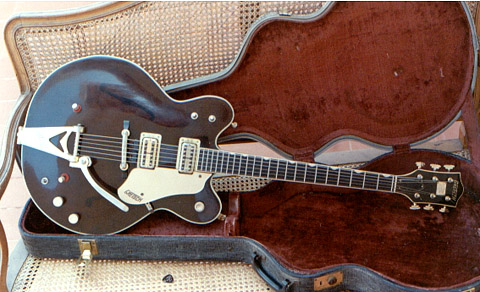
The Playmate of the Month
GRETSCH CHET ATKINS COUNTRY GENTLEMAN, 1964

Chet Atkins' endorsement is one of the most interesting pages in the long history of Gretsch Company: Since the mid-50s the New York facility built some of the greatest guitars ever produced by Gretsch. If the "Chet Atkins Hollow Body", better known as 6120 model, was the family progenitor, with plenty of western appointments (‘G’ brand, and lots of western symbols), and solid-body 6121 was its almost as flashy little-sister, the "Chet Atkins Country Gentleman" had a completely different style.
Swept the board from all that showiness halfway between macho and childish that still is the most charming aspect of cow-boy guitars, Country Gentleman, introduced in 1958 as 6122 model, was at the top of ‘Atkins’ line, and such status is underlined by every detail. Single cutaway, ebony fretboard, FilterTron pickups, gold hardware, B-6 Bigsby , are evident analogies with 6120.
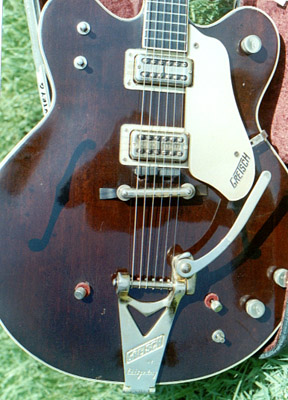 |
But as much evident are the differences: dark mahogany finish brings a touch of elegance and severity, and other details add a classy look: among others, golden headstock plate with model's name and serial number, beautiful stair-step Grover Imperials also used by Gibson and D’Angelico for their best guitars. 6122 is to 6120 as the country gentleman, taken off his spurs and sitting next to the chimney, is to his chief herdsman with lazo and gun out in the mud. There were also more structural differences: in those years 6120 Hollow Body had very rigid bracing to contrast feedback, and the Country Gentleman made the next step: ‘f’ holes were 'fake', made of two plastic panels slightly recessed from the top level. This enabled the 6122 to play louder, while retaining tonal peculiarities of hollow-bodied guitars. Even body dimentions were lager (17" instead of 16"), with 2 3/4" inch depth. |
With its di $ 525 price tag, lower only than White Falcon's, 6122 was at the top of Chet Atkins line: 6120's price was 420 and 6119 Tennessean, introduced in late ’58 was the ‘entry-level’ model of the serie. These instruments, inspired by the Nashville star, gained a world-wide fame thanks to a musician who came from overseas. He was playing in a group called The Beatles, and not exactly country music: already owner of a Gretsch (a '57 Duo-Jet), George Harrison embraced a '63 Country Gentleman for some of the happiest years of his career. The guitar you see here, produced at the beginning of 1964, is identical in every respect to Harrison's. It's easy to see that there are many differences between this version and the early one: first, double-cutaway body shape, called "ElectroTone" in Gretsch's colourful language, replaces single-cutaway style, body depth is reduced to 2"; ‘f’ holes are just painted-on in black, and Bigsby B-6 is replaced by modern "V-cutout" with Gretsch logo.
|
The model keeps all the high-class features, and is even more enriched with a double mute with separate lever switch, which can be used only on the three bass strings or the three treble ones. Circuitry follows the classic Gretsch scheme of those years, with individual pickup volume controls, master volume knob, tone and pickup selection switches, and a third switch that acts as a stand-by, used to 'turn off' the guitar without disconnecting from the amp. Not less than eight devices show off from the guitar's top, in the classic Gretsch-style. |
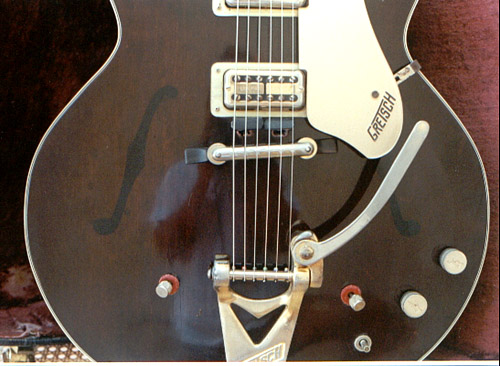 |
The back of our Country Gentleman is not less showy: a black-leather backpad covers circuitry plastic-plate, and on the back of the headstock the beautiful art-deco design of Grover Imperials tuners adds a distinctive classy-touch. The headstock front features T-Roof logo and a golden plate with model's name and serial number.
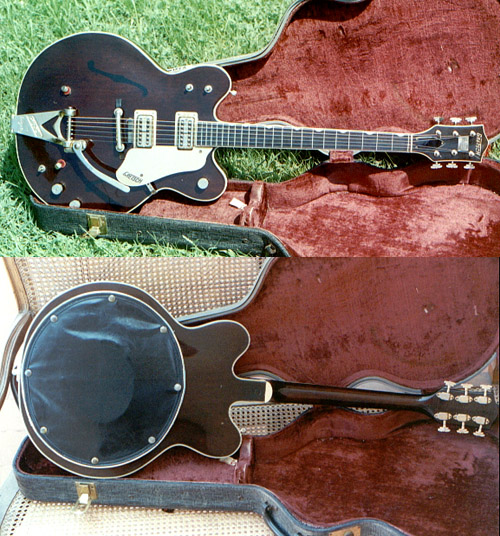
For the Gretsch collector, 6122's value is strongly connected to details that set ‘Harrison’ version apart from later ones, that are far less sought-after and prized also because they were produced in a much higher quantity, due to success of un-official George's endorsement . From mid-’64, many changes were introduced: serial number is no more on the headstock plate, Grover Imperial tuners are replaced by even heavier kidney-button, black felt-pads replace red ones under the mute lever-switches, and model's name is added to Gretsch logo on the pickguard . One of the most important modifications was the replacement of one of the two FilterTrons with a new-generation humbucking pickup called SuperTron, which by the way never encountered players' favour and was taken off again in ’67. In that same year the double mutes were replaced by a more conventional single-switch model.
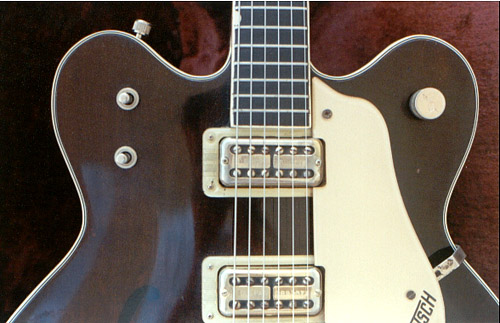
|
|
Who is still far from Gretsch-craze could take these words as a fetihist's obsession. And maybe he wouldn't be wrong. But upon these obsessions is founded an important part of collecting, not only for Gretsch and not only for guitars, with heavy consequences on market's prices and on many family budgets alas..... And when it comes to guitars, visual suggestions evoked by various models are enriched by 'living' factors such as sound, neck profile or fretboard's smoothness… and among most irresistible six.string mermaids, the classic-version Country Gentleman shown here, has all the elements of myth, history, charme, beauty and utility, which make of the electric guitar one of the most meaningful symbols of our time. |